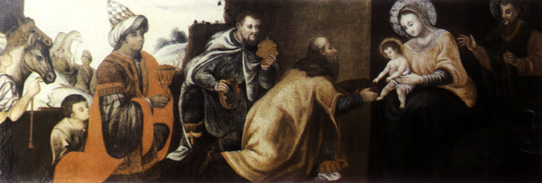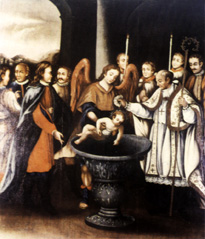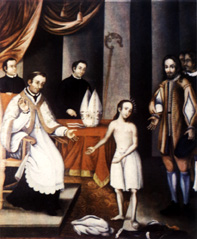SAINT MICHAEL (Japanese Painting)
This is a massive painting reflecting two cultures; the West is represented by the Archangel, Saint Michael; the East is represented by the fiery energy of a dragon chasing evil spirits.
This painting is restlessly alive. Saint Michael's cape rises in a whirl, his fringed breastplate clatters as the warrior moves. He wields his sabre as if it were a live serpent while his huge wings flap. On his head he wears a plumed helmet behind which there is a halo of bright rays.
From head to toe he is dressed in light, floating garments pinned with clasps of precious stones.
A weighty, vertical, thick chain holds fast an image of Christ on the Cross. A strong ring keeps it locked to a heavy slab on the bottom right which has been moved aside to give a glimpse of Hell. On the left, flames dance at his feet giving the impression of war. Red is the dominant colour in this painting.
When Saint Michael cuts the chain, he will free the image of Christ thus releasing the doctrine of Christ to the Orient.
In this painting the two cultures meet through Art. Saint Michael, like the terrifying, iron-clad warriors who guard the temples of the East, brandishes his sword at the ready.
The two cultures meet and fuse. Saint Michael, dressed in the manner of a warrior from the East, is portrayed in the artistic style of 17th century European paintings. This is truly a beautiful painting. It is also unusual for having been painted on wood despite its great size.
THE DESCENT FROM THE CROSS
Sadly, something is lacking in this "descent from the Cross". It is lifeless. Not one of the faces shows any emotion. The body of Christ is of interest as it evokes some Byzantine Christ. Perhaps the "death" of this painting is due to bad restoration work.
THE ADORATION OF THE MAGI (Anonymous Painter)
The three Wise Men have just arrived but the journey is not yet over. The restless horses are held by their reins as the camels arrive in the background.
It is as if the observer were seated on a camel to view this work. We are acutely aware of the journey. Starting at the left of the picture the artist follows a line from the arm holding the reins, to the point on Balthazar's turban. Then it turns downward to the hand holding the myrrh. From there it rises again, this time up Melchior's gown towards his face. It then descends, following the line of his nose and the incense held in his left hand. Thus we arrive abruptly at the shoulder and arm of Caspar who is offering an open box of gold to the Infant. Our vision is now directed up the child's chubby arm towards the Virgin's attentive face. Our eyes move slowly from her shoulder to her sleeve. Joseph's hand reminds us of a sand dune rippling towards his anxious face. We finish up with Joseph, a pious, simple man.
In effect, this picture tells the story of a journey, a journey whose progress is abruptly interrupted by the vertical line of a shady wall bringing the Holy Family into relief. We can forget the long journey and the heat of the desert. After a stormy night, the Three Wise Men arrive with the first, peaceful, glimmerings of dawn.
Caspar, the oldest, is the first to offer his gift. His hat is placed on the ground beside his knees. Painted in red, the hat attracts our attention, highlighting the humility and respect shown by this king to the child.
Melchior, the Second Wise Man, with pursed lips, is impatient and nervous. In one hand he holds a crown and, in the other, incense contained in a ciborium of worked gold.
This painting has been restored many times - Balthazar's red cape has lost its depth. On Caspar's gown we can still see a beautiful, Renaissance decoration of red flowers on a gold ground.
A painting which has been restored loses not only its layers of darkened varnish, but also the delicate touches of the artist. It cannot be given a face-lift without also destroying a part of its soul.
This painting, however, has managed to retain much of its original beauty. A glance at the Virgin's face carries us back to the seventeenth century, an era when religion and prayers formed part of the daily activities in lives that were dominated by the forces of nature - an era when sunlight was the most dazzling light known.
What a journey!
FOUR 17TH CENTURY PAINTINGS DEPICTING THE LIFE OF SAINT FRANCIS (Anonymous Painter)
The first pair in this group show his life before committing himself to God. Figures in magnificent dress stand out against a background of dark walls.
The second pair are country scenes with hills, streams, trees and birds. In the distance there is a substantial, white monastery.
The first painting in this sequence shows the baptism of Christ. A group of nobles on the left discuss, anxiously, the child's future. An angel holds Francis over the baptismal font symbolising a life of devotion and poverty for this child from a wealthy family.
In the second panel we are attracted by the figure of a halfnaked child showing a gesture of denial. His white skin is in sharp contrast to the wealthy apparel of the earthly beings who reflect an institutionalized authority.
 "The Adoration of the Magi"(17th C.)
"The Adoration of the Magi"(17th C.)
 "The Baptism of Saint Francis"
"The Baptism of Saint Francis"
 "Saint Francis Leaving Home"
"Saint Francis Leaving Home"
The thick walls and wellcarved furniture give us the impression of a place with no escape. A heavy, plush curtain draped on the left adds to this sense of oppression. It reflects the difficult moment when a child reaches adulthood and when the adult, represented as a child (Saint Francis was already twenty four) has to confront his father and society. He rejects his clothes and a mundane existence with an abrupt gesture. This is the courage which makes him a man, the contented man of the third painting who preaches to birds in the countryside with his hands raised up to heaven. Two monks watch him in raptures. This painting has a gentle atmosphere. On the left a stream leads us to the promised land. After forty days fasting in retreat in the mountains, Francis sees a vision of Christ on the Cross. In the last painting the artist shows us Saint Francis in that sublime moment when he thrusts himself forward to embrace Christ in total abandon. He is so similar to Christ that the marks of the stigmata appear on him also. This painting is a reflection of how deeply moved the artist was by this glorious episode in Francis' life.
What a sensitive heart this artist has! He tells us the story of the stages in Christ's life simply yet passionately in a spontaneous naive style. The sober colours reflect rural life as opposed to the vibrant colours typical of the luxuries in the cities of the Orient.
These are four paintings by an artist with simple taste who had a profound faith in Saint Francis.
THE MARTYRS OF JAPAN
This is a painting within a painting to highlight the event which it represents.
The artist is letting us know that innocent people were tortured to death. By looking at the general features in the painting we immediately realize that these martyrs were saints.
From both the bottom left and bottom right hand corners two lines of crucified men rise and converge in heaven. They are transformed into thunderous clouds: the overcast sky is witness to the atrocity. Some angels fight through the clouds to welcome the new souls. Christ on the crucifix appears in a heaven which is open to the martyrs at the centre of the picture. The central position of heaven gives it a comforting quality.
At the bottom of the picture we are on earth. There is an oppressive atmosphere. A group of men and women on the right are praying. A mother points out the martyrs to her son: "Watch, and don't forget!".
On the left the Japanese army is determined in performing its duty; every spear stands upright guiding our eyes up to heaven, the last resting place for the believers. Behind the scene of the crucifiction is a calm sea which evokes the peace beyond death. On the left, a boat with its sails rolled up, symbolizing the last journey, points towards heaven.
Our eyes are always called back to the three figures on the right watching the deathly scene from a distance. They represent an institution, order, normality. Are they there as witnesses? Is the artist also present? The dominant colour in this painting is dark brown, the colour of the earth, of man's suffering on earth. But there is also blue, the colour of peace after suffering, of heavenly blessings.
This 17th century painting has aged beautifully. The colours have faded and gently merged. It could almost be a 16th century tapestry which had hung for years on the damp wall of a medieval castle.
This is an innocent painting of innocent people painted simply.
The artist wanted to say something. He pleads with us: "Don't forget, this did happen".
SAINT SEBASTIAN (Guido Reni, 1575-1642)
His body hangs in the air, with his feet gently touching the ground. An air of sanctity emanates from Saint Sebastian. He is distant from everything. Three arrows pierce his body yet this is not a bloody scene. Sebastian does not seem to feel any earthly pain or degradation. In spite of his suffering he remains saintly and celestial.
His tunic, draped over his hips, flows around his legs as if blown by angels. It hardly even touches him. The cloth has a voluptuous, filmy quality born from spiritual love. Even the knot seems to have been tied by celestial clouds. This picture evokes weightlessness and yet the left side of his body arches towards the left in a very natural movement.
He is looking up to heaven where golden rays of light emanate inspiration. Saint Sebastian is truly under heavenly protection. He is mesmerised by the shining light. He has forgotten the pain. This is the moment of his transformation from man into saint. All the same we cannot but notice the seductiveness of his face: the adolescent nose, not particularly elegant but very masculine, the nostrils slightly flared, the full, childish lips parted with no self-consciousness. All of this attracts our attention. And we would be more than happy if Saint Sebastian were to take a glance at us.
His body is pale and gentle. A drop of blood slowly drips down his chest. When we look at him, with a tinge of desire, we notice that his tunic is draped round his hips with the folds hanging just where they are most necessary.
This saint is seductive. He is a man.
Guido Reni's painting has an ethereal, divine quality about it and yet with the same brush he manages to convey images of seduction and beauty which are principally wordly pleasures.
To bring these two qualities together requires the skill and understanding of a great artist.
There is no doubt that the stamp of the renowned 17th century artist, Guido Reni, is imprinted on this picture.
Translated from the French original by Luís Gonçalves
Translated from Portuguese by João Libano
* Specialist in restoring religious art. Responsible for the restoration of some paintings and sculptures in the Seminário de S. José.
start p. 59
end p.